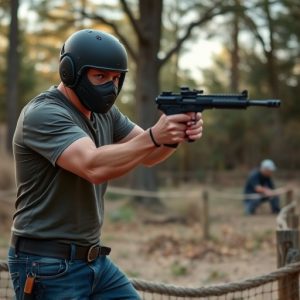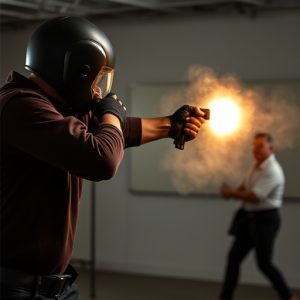Senior Safety: A Comprehensive Review of Stun Gun Mechanisms
Non-lethal self-defense weapons, specifically stun guns, are gaining popularity among seniors as a s…….
Non-lethal self-defense weapons, specifically stun guns, are gaining popularity among seniors as a safe alternative for personal protection. These devices use electric shocks to temporarily disable attackers without causing harm. Their compact design and ease of carry make them convenient for seniors to defend themselves in various situations, promoting independence and enhanced safety. However, optimal usage requires understanding range limitations, power settings, and regular practice, especially considering diverse physical abilities. Legal considerations vary by jurisdiction, with many regions allowing low-voltage stun guns but having age limits, registration requirements, and specific prohibited locations. Regular training, familiarization with safety mechanisms, and proper maintenance are essential for effective and reliable use of non-lethal self-defense weapons like stun guns.
“In today’s world, ensuring senior citizens’ safety is of utmost importance. One growing trend in personal protection is the adoption of non-lethal self-defense weapons, particularly stun guns. This comprehensive review delves into the world of non-lethal self-defense tools tailored for seniors. We explore their role in enhancing personal security and provide an insightful analysis of how stun guns work, highlighting their effectiveness as a deterrent.
Key features, legal considerations, and best practices are dissected to empower seniors and caregivers with essential knowledge, ensuring informed decisions regarding this life-saving technology.”
- Understanding Non-Lethal Self-Defense Weapons for Seniors
- The Role of Stun Guns in Senior Safety
- How Stun Guns Work and Their Effectiveness
- Key Features to Consider When Choosing a Stun Gun
- Legal Considerations for Carrying Stun Guns
- Best Practices for Using and Maintaining Stun Guns
Understanding Non-Lethal Self-Defense Weapons for Seniors
Non-lethal self-defense weapons, also known as stun guns, are gaining popularity among seniors seeking effective personal safety measures. These devices are designed to incapacitate an aggressor temporarily without causing permanent harm, making them an appealing option for those who want to protect themselves while avoiding lethal force. Stun guns work by delivering a powerful electric shock that disrupts muscle control, allowing the user to escape or deter an attack.
For seniors, the primary benefit lies in their ease of use and non-lethal nature. Many stun guns are compact, lightweight, and easy to carry, fitting comfortably in a purse or pocket. This accessibility ensures that users can defend themselves in various situations, whether walking alone, traveling, or feeling vulnerable in unfamiliar places. Understanding how these weapons work and practicing their use can empower seniors to maintain their independence while enhancing their overall safety.
The Role of Stun Guns in Senior Safety
In today’s world, ensuring safety is a paramount concern, especially for senior citizens who may be more vulnerable to potential threats. Non-lethal self-defense weapons, such as stun guns, have emerged as valuable tools for enhancing personal security, particularly for seniors looking to protect themselves in various scenarios. These devices offer a layer of protection without resorting to lethal force, making them an appealing option for those seeking peaceful yet effective deterrents.
Stun guns are designed to temporarily incapacitate an aggressor through electric shock, allowing the user to escape or seek help. For seniors living alone or those with limited mobility, such non-lethal weapons can provide a sense of security and peace of mind. They offer a swift response in close-quarters situations, ensuring that individuals have the means to defend themselves until assistance arrives. With proper training and understanding of their functionality, stun guns can empower seniors to maintain their independence while prioritizing safety.
How Stun Guns Work and Their Effectiveness
Stun guns, also known as electronic control devices (ECDs), are designed to incapacitate an aggressor with a powerful electric shock, providing an effective non-lethal self-defense option for seniors and individuals seeking personal safety. These weapons emit a high-voltage, low-current electrical pulse that disrupts muscle control in the target area, causing temporary paralysis and pain. The energy is typically delivered through two prongs or probes held by the user, which make contact with the assailant’s body.
The effectiveness of stun guns lies in their ability to stop an attacker quickly without causing permanent harm. Studies show that a well-placed stun gun shot can render an aggressor unconscious for several minutes, providing valuable time for the victim to escape or summon help. However, factors like range, power settings, and the training of the user play significant roles in determining the outcome. Regular practice and understanding the device’s limitations are crucial for optimal effectiveness, especially for seniors who may have varying physical capabilities.
Key Features to Consider When Choosing a Stun Gun
When choosing a stun gun, several key features should be top of mind, especially for seniors seeking non-lethal self-defense options. First and foremost, consider the device’s ease of use; simple, intuitive designs are ideal for those who may not have as much strength or dexterity in their hands. Look for models with large, easy-to-press triggers and clear control buttons to ensure quick deployment during an emergency.
Additionally, weight and size matter. Seniors might prefer lighter options that are comfortable to carry without causing strain on the body. Waterproof designs can also be advantageous, providing peace of mind in various weather conditions. Remember, a stun gun’s effectiveness is only as good as the owner’s ability to use it, so choosing one that aligns with your comfort level and physical capabilities is essential for confident self-defense.
Legal Considerations for Carrying Stun Guns
Carrying a stun gun, also known as an electronic control device (ECD), comes with its own set of legal considerations, especially when it comes to non-lethal self-defense weapons designed for seniors or individuals looking for personal safety. The legality of stun guns varies significantly from one jurisdiction to another. It’s crucial to understand and comply with local laws and regulations before purchasing and carrying such a device.
In many regions, stun guns are legal if they meet certain criteria, such as having a low voltage output designed primarily for non-lethal use. However, restrictions may include age limits (often 18 years or older), registration requirements, and prohibited locations like schools, courts, or airports. Some areas also mandate training or permits for carrying stun guns openly or concealed. Always check with your local law enforcement agency or legal counsel to ensure you’re aware of and adhering to the specific rules regarding non-lethal self-defense weapons in your region.
Best Practices for Using and Maintaining Stun Guns
When it comes to non-lethal self-defense weapons for seniors, stun guns offer a viable option for personal safety. Best practices dictate that users should always aim for the center mass of the target—the chest or stomach area—to maximize effectiveness while minimizing the risk of severe injury. Regular training and familiarization with the device’s safety mechanisms are essential to ensure proper usage.
Maintenance plays a crucial role in keeping stun guns reliable. Users should clean their devices regularly, following manufacturer guidelines, to prevent buildup of dirt and debris. Testing the stun gun periodically, both at home and during refreshers courses, helps ensure it is functioning optimally. Storing the device securely, out of reach of children and unauthorized individuals, is another critical safety measure.
Stun guns offer a valuable tool for seniors seeking non-lethal self-defense options. By understanding their functionality, legalities, and best practices, individuals can make informed decisions to enhance their personal safety. When choosing a stun gun, consider key features tailored to individual needs, ensuring it becomes a reliable companion for peace of mind in today’s world.


